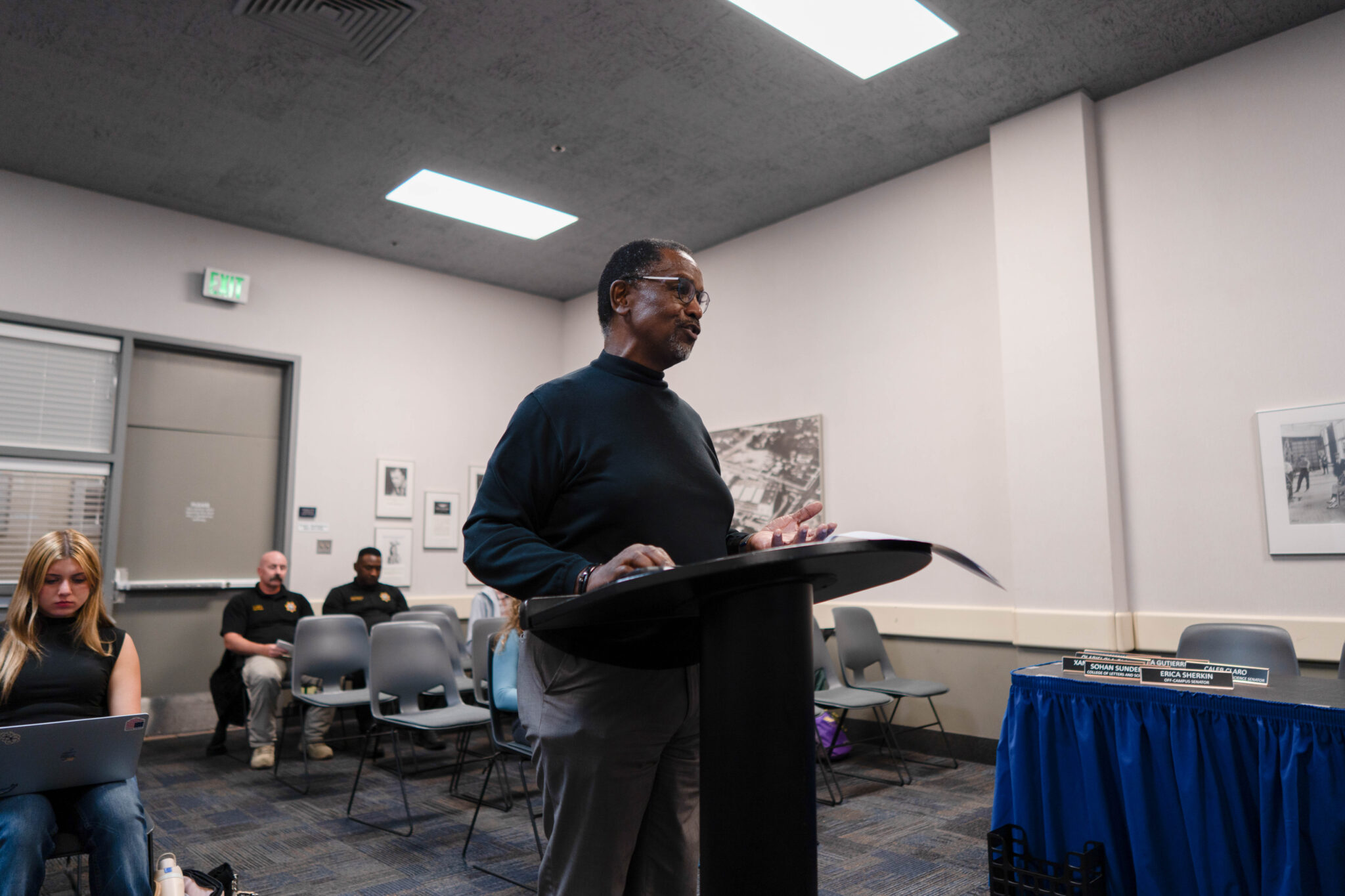The 76th Associated Students Senate heard updates on university housing developments and UC Police Department bike enforcement plans at its Oct. 22 meeting.

Willie Brown is in favor of increasing the University’s student population because it brings in more student fees and opportunities for development. Shengyu Zhang / Daily Nexus
UC Santa Barbara has begun the first phase of a two-phase housing development project for undergraduate students. Housing, Dining & Auxiliary Enterprises Associate Vice Chancellor Willie Brown announced that construction has begun on the San Benito Student Housing project, which will provide 2,224 undergraduate students with apartment-style housing and is scheduled for completion in the fall of 2027.
San Benito is replacing the Munger Hall housing project, previously part of the Mesa Verde housing proposal. In 2014, Berkshire Hathaway Vice Chairman Charles Munger proposed Munger Hall and pledged $200 million to the plan, which was designed to house 4,536 single dorms on nine floors of the 11-story building. Many rooms did not have window access, so Munger proposed artificial LED panels to serve as virtual windows.
The lack of windows and density of the proposed dormitory sparked concern and drew national criticism, including comments from a campus architect who resigned over safety and design concerns. The University eventually abandoned the plan.
“We should have never gotten involved with Charlie Munger,” Brown said. “That is costing us at least half a million dollars, maybe more, in terms of bad decision-making.”
Despite UCSB only having space to promise first-year housing security, Brown is in favor of increasing the University’s student population because it brings in more student fees and opportunities for development. He noted that the University has not been smart about its spending in the past and hopes that the University’s new chancellor, Dennis Assanis, addresses the school’s financial and housing problems in a “more collaborative way.”
The university plans to add housing for 1,275 students on the east side of campus as part of Phase Two of its housing project. UCSB has not yet begun construction on the East Campus Housing project, but plans to demolish the Santa Rosa Residence Hall at the end of the 2025-26 academic term, as well as open the new east-campus housing in the fall of 2028 according to Brown. He also said the University has the goal to convert Ortega Dining Commons into a 24-hour take-out dining hall.
Next, UC Police Department (UCPD) Corporal Ariel Bournes shared UCPD’s Community Outreach Team’s proposed solution to bicyclist and pedestrian collisions between the Davidson Library and the Interactive Learning Pavilion. Bournes oversees the Community Outreach Team and introduced their focus on Crime Prevention Through Environmental Design (CPTED). CPTED aims to encourage law abidance through environmental design, rather than more typical forms of enforcement, such as citations or arrests.
The city of Santa Barbara implemented pedlets, manufactured pedestrian walkways, as a form of CPTED, and Bournes suggested that UCSB could use pedlets as a temporary solution until the bike path, which will serve as the long-term solution, is completed.
“We’re not necessarily going to be able to eliminate this issue as far as bicyclists and pedestrians intermingling, but we certainly can reduce the harm associated with it,” Bournes said.
Bournes acknowledged that there are drawbacks to implementing pedlets, the most significant being how expensive they are for a temporary solution. Santa Barbara spent around $528k for each block of pedlets on State Street, and given UCSB’s stricter safety and accessibility requirements, implementing them on campus would likely be more expensive.
Associated Students (A.S.) Off-Campus Senator and third-year economics and philosophy double major Noah Luken asked Bournes where he anticipated the funding would come from, and if that money would be better served if it went towards the bike path. Bournes admitted that he did not have an answer to that yet, as this plan is in its “beginning phase.” He stressed the need for community collaboration in finding a solution and explained that UCPD will begin looking into details such as funding only after “logging the community’s feedback.”
First President Pro Tempore and second-year political science major Evan Sussman asked Bournes about UCPD’s reaction to the recent crimes on campus. On Oct. 20, there was an attempted sexual assault in the grass area by the lagoon, along with anti-Black vandalism outside of the Arts Building. The Dean of Students addressed both incidents in a university-wide email on Oct. 22.
In response to the recent assault, the Chief of Police instructed the Community Outreach Team to design a new route that includes the Lagoon area during the annual Lighting and Safety Walk, which addresses areas on campus that are dark or unsafe, and searches for environmental solutions. Bournes said that as soon as he finishes designing the new route, he will email students to invite them to attend the walk.
Next, External Co-President Laura Snell and Vice President of Graduate Student Affairs (GSA) Patrick Tugwell reported they are in year two of restructuring GSA. They have plans to re-engage with different campus organizations, including the Senate, that they feel the GSA has not been connected with in previous years.
Snell explained that they have an increased budget this academic year, a majority of which will go to travel grants for research conferences and childcare grants for graduate student parents. They also have goals to request a fee increase so they can hire staff.
During public forum, fourth-year economics and environmental studies double major Leo Brown re-presented his initiative to put sustainable laundry detergent sheets in University laundry rooms in collaboration with an environmental justice startup Generation Conscious. The sheets would be offered to students for free and would begin as a pilot program partially funded by the Senate if passed. The project was referred to the advocacy committee.
Then, A.S. Attorney General and fifth-year economics and communication double major Taylor Iden suggested that the Senate write legislation that would make all Boards, Committees and Units (BCUs) follow Robert’s Rules of Order — a guide for conducting meetings. This came from concerns over BCUs passing large amounts of money without taking attendance or recording votes during meetings.
Judicial Council (JC) chair and fourth-year political science and philosophy double major Josie Penix presented her summer project, the JC Bench Book, which lays out all the processes, procedures and rules of the JC. Penix said this project was inspired by the many “high-profile” cases the JC handled last spring that brought a lot of attention to their procedures.
Next, the Senate passed A Bill to Update Standing Policy 4 of Legal Code to codify that late additions to the Senate’s agenda must be made aware to the Senate, and to remind senators to review all agenda points before the meetings, which was reported out of the liaison committee without amendments.
The Senate concluded by passing $3600 in honoraria from Senate Unallocated to the Office of the Attorney General for the purpose of hiring three additional caseworkers to have a “full bench” for each side of a trial.
A version of this article appeared on p. 3 of the Oct. 30 print edition of the Daily Nexus.




















